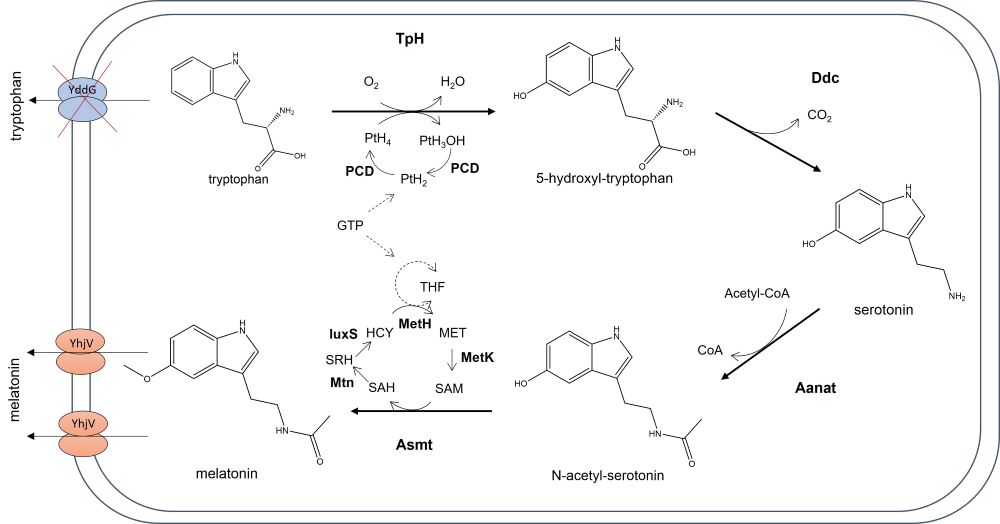Biomanufacturing of melatonin is now possible
Biomanufactured melatonin
Abstract
Currently, the majority of the melatonin manufactured is chemically synthesized replacing the previous method that extracted it from biological materials. Due to environmental concerns, biomanufacturing of chemical-related products is now gaining favor over chemical synthesis. Melatonin is synthesized from tryptophan in a four-step pathway that includes a hydroxylase and methyl transferase, both representing major challenges for metabolic engineering. Using novel technologies, including genome editing and laboratory evolution, the metabolic pathway of melatonin synthesis has been reconstructed in a microbial host which has the capacity to produce melatonin in gram-level quantities.
References
2. Meng J-F, T-C Shi, S Song, Z-W Zhang, Y-L Fang (2017) Melatonin in grapes and grape-related foodstuffs: A review. Food Chem. 231: 185–191.
3. Rusanova I, et al. (2019) Protective effects of melatonin on the skin: Future perspectives. Int. J. Mol. Sci. 20: 4948.
4. Gao T, et al. (2022) Introducing melatonin to the horticultural industry: physiological roles, potential applications, and challenges. Hortic. Res. 9: uhac094.
5. nawaz k, et al. (2020) melatonin as master regulator in plant growth, development and stress alleviator for sustainable agricultural production: current status and future perspectives. Sustainability 13: 294.
6. stacchiotti a, g favero, lf rodella (2020) impact of melatonin on skeletal muscle and exercise. Cells 9: 288.
7. Gunata M, H Parlakpinar, HA Acet (2020) Melatonin: A review of its potential functions and effects on neurological diseases. Rev. Neurol. (Paris) 176: 148–165.
8. (2022) Data from “Melatonin Market Size And Forecast.” https://www.verifiedmarketresearch.com/.
9. Brusco LI, et al. (2021) Efficacy of melatonin in non-intensive care unit patients with COVID-19 pneumonia and sleep dysregulation. Melatonin Res. 4: 173–188.
10. Gurunathan S, M-H Kang, Y Choi, RJ Reiter, J-H Kim (2021) Melatonin: A potential therapeutic agent against COVID-19. Melatonin Res. 4: 30–69.
11. Juhnevica-Radenkova K, DA Moreno, L Ikase, I Drudze, V Radenkovs (2020) Naturally occurring melatonin: Sources and possible ways of its biosynthesis. Compr. Rev. Food Sci. Food Saf. 19: 4008–4030.
12. (2022) Data from “Melatonin Market by Product and Geography - Forecast and Analysis 2022-2026.” https://www.technavio.com/report/.
13. Lin Y, X Sun, Q Yuan, Y Yan (2014) Engineering bacterial phenylalanine 4-hydroxylase for microbial synthesis of human neurotransmitter precursor 5-hydroxytryptophan. ACS Synth. Biol. 3: 497–505.
14. Wang H, et al. (2018) Metabolic pathway engineering for high-level production of 5-hydroxytryptophan in Escherichia coli. Metab. Eng. 48: 279–287.
15. Mora-Villalobos J-A, A-P Zeng (2018) Synthetic pathways and processes for effective production of 5-hydroxytryptophan and serotonin from glucose in Escherichia coli. J. Biol. Eng. 12: 3.
16. Germann SM, et al. (2016) Glucose‐based microbial production of the hormone melatonin in yeast Saccharomyces cerevisiae. Biotechnol. J. 11: 717–724.
17. Luo H, et al. (2020) Microbial synthesis of human-hormone melatonin at gram scales. ACS Synth. Biol. 9, 1240–1245.
18. Luo H, et al. (2019) Coupling S-adenosylmethionine–dependent methylation to growth: Design and uses. PLOS Biol. 17: e2007050.
19. Luo H, et al. (2020) Directed Metabolic Pathway Evolution Enables Functional Pterin-Dependent Aromatic-Amino-Acid Hydroxylation in Escherichia coli. ACS Synth. Biol. 9: 494–499.
20. Kunjapur AM, JC Hyun, KLJ Prather (2016) Deregulation of S-adenosylmethionine biosynthesis and regeneration improves methylation in the E. coli de novo vanillin biosynthesis pathway. Microb. Cell Factories 15: 61.
21. Lopes JG, V Sourjik (2018) Chemotaxis of Escherichia coli to major hormones and polyamines present in human gut. ISME J. 12: 2736–2747.
22. Pereira R, et al. (2019) Adaptive laboratory evolution of tolerance to dicarboxylic acids in Saccharomyces cerevisiae. Metab. Eng. 56: 130–141.
23. Malla S, et al. (2022) A novel efficient l-lysine exporter identified by functional metagenomics. Front. Microbiol. 13: 855736.
24. van der Hoek SA, I Borodina (2020) Transporter engineering in microbial cell factories: the ins, the outs, and the in-betweens. Curr. Opin. Biotechnol. 66: 186–194.
25. Genee HJ, et al. (2016) Functional mining of transporters using synthetic selections. Nat. Chem. Biol. 12: 1015–1022.
26. yang l, et al. (2022) identification and engineering of transporters for efficient melatonin production in Escherichia coli. Front. Microbiol. 13: 880847.
27. zhao d, et al. (2019) melatonin synthesis and function: evolutionary history in animals and plants. Front. Endocrinol. 10: 249.
28. O’Donnell A, Y Bai, Z Bai, B McNeil, LM Harvey (2007) Introduction to bioreactors of shake-flask inocula leads to development of oxidative stress in Aspergillus niger. Biotechnol. Lett. 29: 895–900.
29. Gulcin İ, ME Buyukokuroglu, OI Kufrevioglu (2003) Metal chelating and hydrogen peroxide scavenging effects of melatonin: Metal chelating and H2O2 scavenging of melatonin. J. Pineal Res. 34: 278–281.
30. He F, et al. (2022) Melatonin inhibits Gram-negative pathogens by targeting citrate synthase. Sci. China Life Sci. 65: 1430–1444.
31. Moreno AD, C González-Fernández, M Ballesteros, E Tomás-Pejó (2019) Insoluble solids at high concentrations repress yeast’s response against stress and increase intracellular ROS levels. Sci. Rep. 9: 12236.
32. Zautsen RRM, et al. (2009) Liquid-liquid extraction of fermentation inhibiting compounds in lignocellulose hydrolysate. Biotechnol. Bioeng. 102: 1354–1360.


This work is licensed under a Creative Commons Attribution 4.0 International License.
For all articles published in Melatonin Res., copyright is retained by the authors. Articles are licensed under an open access Creative Commons CC BY 4.0 license, meaning that anyone may download and read the paper for free. In addition, the article may be reused and quoted provided that the original published version is cited. These conditions allow for maximum use and exposure of the work, while ensuring that the authors receive proper credit.
In exceptional circumstances articles may be licensed differently. If you have specific condition (such as one linked to funding) that does not allow this license, please mention this to the editorial office of the journal at submission. Exceptions will be granted at the discretion of the publisher.


